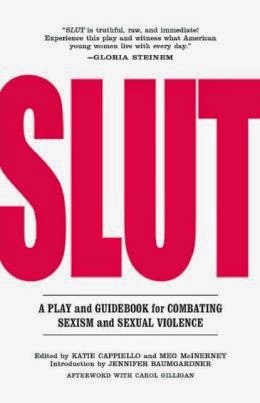So you're digging feminism and want to find out more? Excellent! I know it seems daunting to stare into the face of women's studies literature and to come out the other side more informed and confident instead of sobbing with overwhelmed emotion, but you can do it. Just like feminism is a lot simpler than people try to make it out to be - it is, after all, only "the radical notion that women are people"* - the world of feminist non-fiction need not be over-challenging. Below are my suggestions for where to start your reading - many of these are newer titles because I personally feel like the dialog is more relevant than some of the classic feminist books and I also find them easier to read. Feel free to leave your own suggestions or questions in the comments!

Sexy Feminism: A Girl's Guide to Love, Success, and Style by Jennifer Keishin Armstrong & Heather Wood Rudúlph
by Jennifer Keishin Armstrong & Heather Wood Rudúlph
As a bonafide feminist killjoy who's into glitter, makeup and fashion, I jumped for joy at this title. There is still, yes still, a huge misconception that ALL feminists are unshaven bra-burners who hate men. None of which are actually part of the description of feminism. Believing that we're just as human as men doesn't mean we don't like traditionally feminine trappings. Sexy Feminism covers this alleged dichotomy, being a conscientious consumer and being kind to other women.

Men Explain Things To Me (Updated Edition)
I mean, when the titular essay was originally published in 2008, it went viral, and the responses prompted the feminist Internet to coin the now easily recognizable portmanteau, "mansplaining". You could easily entertain yourself for hours by searching out comment threads and reading the male objections to the article, where they all manage to do exactly what the article was discussing in the first place. Men Explain Things to Me contains, of course, that first, historically important essay, along with six other perfectly matched essays.

Colonize This!: Young Women of Color on Today's Feminism
Did you know that women come in more colors than just white? Well, the feminist movement doesn't always appear to know. Colonize This! is important for many reasons, but giving voice to the non-white population is the most important. Mainstream feminism tends to ignore or marginalize issues of race, and that's just not cool.
 Spinster: Making a Life of One's Own
Spinster: Making a Life of One's Own
This is a new one and it's getting a ton of press for a very good reason: despite the multiple waves of feminism to sweep through the last century, a single woman is still an object of pity to too many people. This book helps break through so many preconceptions about what it means to claim your life for yourself. I think this is an important read for everyone, single, dating, married. Because, ultimately, you can't define yourself by your relationship status, and you shouldn't have to defend that status to anyone.
It's not the longest, but it makes a compelling argument. That's probably why we got Adichie's badass Tedx Talk finally printed for mass consumption and distribution. I adore Adichie's point of view because it's not specifically American or western; the fact that she hails from Nigeria helps expand the feminist conversation to the rest of the world. The problems are everywhere and we need to recognize and accept this fact if we're going to move forward.
So here's the thing, feminism sucks if we're not including every woman in it. That means transsexual women, gay women, queer women, women of color, and straight woman. Serano is one of the leading voices in this incredibly important call to action. If your feminism isn't including and respectful of everyone I just listed and if you don't take their special circumstances into consideration, this needs to move to the top of your TBR stack, ASAP.
This essay collection deals with the flaws in us all, especially women, and how we can fixate on what we’re doing wrong instead of embracing all that we’ve done right. Let’s be honest, I think each and every of us has lamented how bad we are at fulfilling all the ideals we claim to support and embody. Gay’s exploration of this theme is cathartic and incredibly resonant. “Bad Feminist” is also a product of a mind that follows pop culture and maintains a strong social media presence, making her inconsistencies and struggles all the more real.
 SLUT: A Play and Guidebook for Combating Sexism and Sexual Violence
SLUT: A Play and Guidebook for Combating Sexism and Sexual Violence
I can honestly say that I have never spent so much time discussing, raving, sharing, dissecting, and meditating on one book before or since reading SLUT. This book contains the titular play (a must-see, watch the Talks at Google here), a background and guide for presenting the play, and several essays pertaining to the subject material. Vitally important for everyone to read, doubly so if you work with teens.
Leora Tanenbaum has been a leading voice on the topic of slut-shaming for years now. This is her newest book on the subject and it's incredible timely. The internet has radically changed the way we interact with and judge one another. Specifically, it has removed a lot of accountability people feel when dealing with others and has led to a generation of teens and young adults being threatened and verbally and emotionally assaulted online.
Also, just go ahead and check out Feministing.com, DameMagazine.com, BUST Magazine and Bitch Magazine. Honestly, just subscribe to those last two.
*Thank you, Marie Shear ♥






